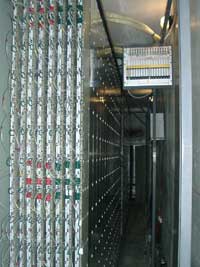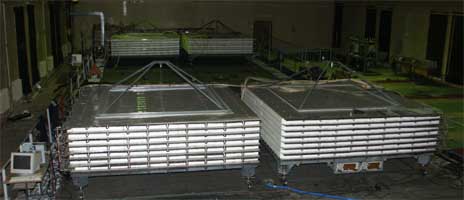|
 Coordinate detectors (DECOR) with total area of 115 m2 are intended for the detailed studies of the spatial and angular characteristics of the muon component of cosmic rays at the Earth's surface.
Coordinate detectors (DECOR) with total area of 115 m2 are intended for the detailed studies of the spatial and angular characteristics of the muon component of cosmic rays at the Earth's surface.
DECOR has a modular structure and includes 12 eight-layer assemblies (supermodules) located around the water Cherenkov detector and consisting of gas-discharge plastic chambers operating in the limited-streamer mode with the external readout of the information. DECOR has a good spatial (< 1 cm) and angular (< 1°) accuracy, making it possible to distinguish the tracks of parallel muons in the groups of large multiplicity.
Coordinate detectors functionally are divided into two parts.
Side coordinate detector (DECOR-S) is intended for registration of the muon component at the large zenith angles. DECOR-S includes 8 vertical supermodules with total area of 70 m2 arranged in the galleries around the NEVOD. The construction of modules and the system of their fastening make it possible to change the configuration of installation depending on the physical task.
Top coordinate detector (DECOR-T) also has eight-layer structure, but it is deployed horizontally on the moving platforms, making it possible to change the mutual arrangement of supermodules as relative to each other, so relative to Cherenkov calorimeter. DECOR-T is intended for the analysis of time-spatial variations of muon flux with the purpose of the study of processes of its modulation as of atmospheric, so of extra-terrestrial origin. The complete configuration of detector includes four platforms, which have total sensitive area 45 m2 and ensure the angular accuracy of about 0.5°.

Detector allows to simultaneously study atmospheric processes in a radius up to 50 km. Therefore installation for the recognition of thunderstorm anomalies (URAGAN) is constructed on the basis of DECOR-T with the support of the Government of Moscow and Moscow Committee of Science and Technologies. The basic task of this installation will be continuous monitoring of the upper atmosphere, the detection of irregular phenomena of the local origin and the determination of the direction of their further propagation.
|